Chalgrove, Oxfordshire (†Oxford) Early C.14
The Death, Burial and Assumption of the Virgin
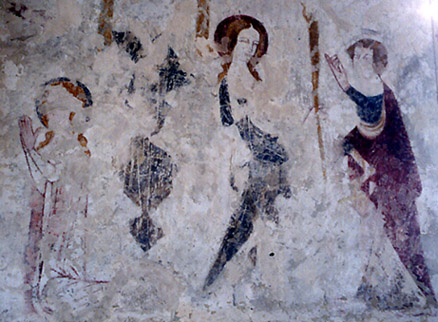
These paintings in the chancel at Chalgrove continue the story of the Virgin which began with the Annunciation painted there. They take up Mary’s story at the end of her life, beginning with the scene at the left, where an angel responds to Mary’s prayers that she might die and be reunited with her Son. At the far left of the scene she is shown kneeling in prayer, and further right, beyond some patchy dark grey pigment (it may once have represented the ‘garment of Paradise’ brought to her from heaven), the reassuring angel presents her with a palm branch from Paradise in token of her death three days hence.
The canonical Scriptures are silent about Mary’s later life, and into this void all manner of speculation and mythology about her earthly end unsurprisingly flowed. On the wall immediately above the scene at the left above (photo, below right) is a painting of the Virgin flanked by two groups of people; on the left St John stands, with a group of other Apostles kneeling in attitudes of grief at the far left.
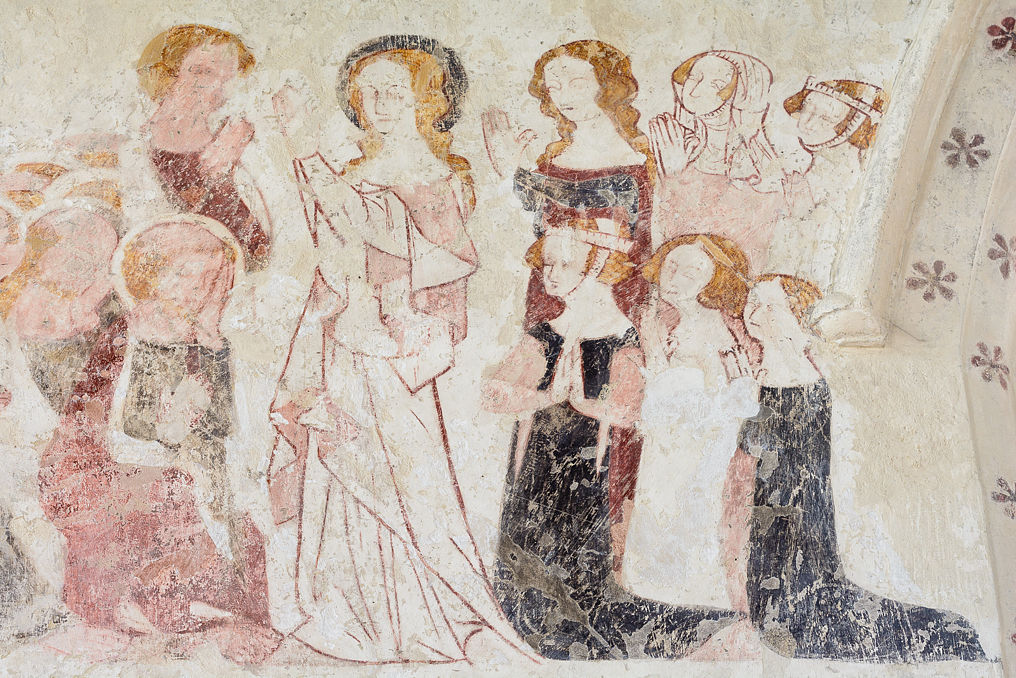
The Virgin stands centrally, hands raised in prayer, and to the right of her are six women wearing early 14th century clothing and headgear, variously standing and kneeling, also in prayer. These are Mary’s neighbours, and the scene nicely encapsulates Mary’s dual nature as Mother of God and ordinary woman living in an ordinary community. In fact it is suggested in the very good guide to the paintings available in the church that these women might represent portraits of local layfolk, despite the fact that the paintings are in the chancel, normally the domain of the priest alone.
The story continues at the left, and it shown at the left below, where Christ stands with his hand extended towards the bier on which his mother lies. Unfortunately little is left of the figure of Mary herself, but Christ’s own figure is reasonably clear, and so are two small angels hovering above, holding Mary’s soul in a napkin.
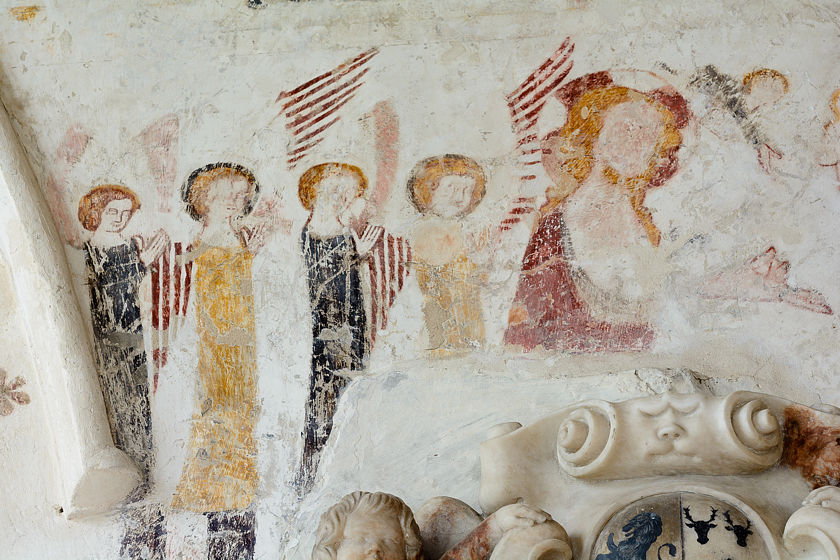
At the right, St John, now holding the palm branch (very difficult to see) given to Mary by the angel, leads a group of Apostles, while four angels stand at the left. Most of the catafalque on which Mary lies is now obscured by the later memorial tablet on the wall.
One of the rarest scenes of all, the actual Burial of the Virgin, is shown at the right below. The bier, draped in an elaborately patterned pall, on which Mary lies is carried by a group of Apostles at either end, with Peter probably at the head of the procession on the far left. Also shown here is the (entirely apocryphal) incident of the Jewish priest’s attempt to interrupt the procession by leaping onto the bier to overturn it. The priest, named Jephonias in one of the earliest apocryphal accounts¹, is shown clinging with one hand to the upper edge of the bier, to which his hands had cleaved irremovably. Two of his companions, only partly preserved, are shown below on the ground, having been struck blind like their leader for their sacrilege.
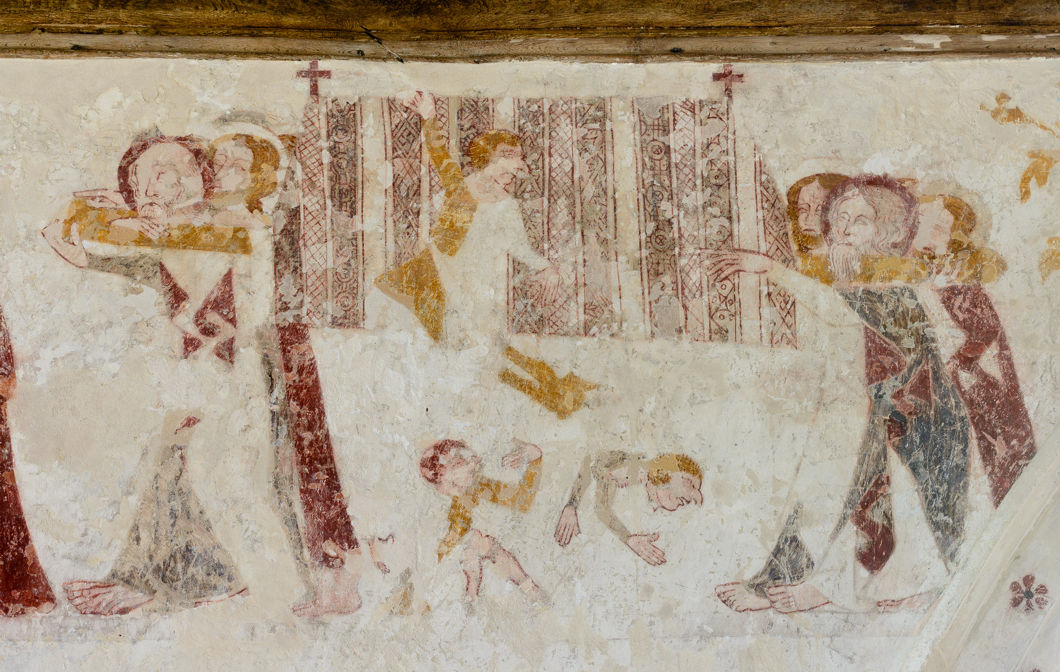
The next scene, however, shows St John, now holding the palm of Paradise given to the Virgin, restoring Jephomias’s sight (photo, left below), while a group of his companions (not shown) further left clasp their hands in prayer to signal the healing of their blindness and their ready embrace of the new faith.
In his right hand, St John holds an aspergillum or holy water brush with which he sprinkles the High Priest In the Middle Ages there were many similar stories of attempted sacrilege directed at Christian rites by Jews, sometimes involving, for example, profanation of the consecrated Host Irretrievably stuck hands often feature, as does magnanimous healing intervention by Christians or even Christ himself, and, of course, instant repentance and conversion.
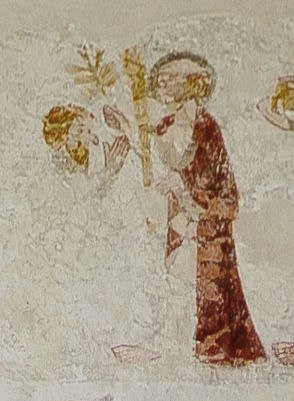
The next scene shows the Apostles sitting at a table, while St Thomas, who had been praying alone in the desert (in India, according to a persistent tradition) shows the others the Virgin’s girdle, handed down by her to him from Heaven when, true to his sceptical nature, he prayed for a sign from her that she had truly ascended there. Unfortunately the girdle-incident is now invisible even on the wall, leaving the only surviving example of it in English church wallpainting known to me that at Broughton, also in Oxfordshire, very faint, but at least visible. The story of Thomas and the girdle, though, seems to have been implicitly believed in the Middle Ages, and it found its way into the Weavers’ play in the York Mystery Cycle².
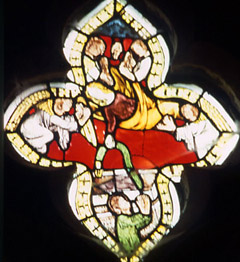
A fine stained glass roundel of the girdle-incident is in the church at Beckley, again in Oxfordshire, and shown here at the right.
The final visible scenes in the Death of the Virgin sequence at Chalgrove are her Assumption and Coronation shown together at the left. These relatively familiar scenes are less well preserved than some of the preceding ones, but they are included here for the sake of completeness. The Assumption – the Virgin with hands clasped before her in prayer in the centre, an angel at the left and traces of another at the right, is below, and the Coronation – the Virgin (seated left) crowned by her Son (seated right) is above.
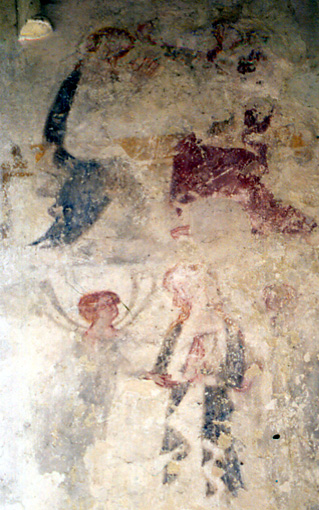
Thus ends the painted story of the Virgin Mary which began at Chalgrove with her supreme position in the Tree of Jesse, and continued through the Annunciation to culminate in these scenes of her later life. Inextricably linked with it, of course, is the Life and Passion of Christ, also painted in the Chalgrove chancel, and this will be here soon. The whole extensive scheme culminates in a Doom, rather fragmentary now, but also here soon, along with the paintings of saints that fill the splays of the windows.
Website for St Mary’s, Chalgrove
¹ For example the Transitus Mariae attributed to John the Evangelist: On the Dormition of Mary:Early Patristic Homilies, ed.Brian J Daley, SJ, New York, 1998, p.7
² The Weavers of Woollen Play, The York Cycle of Mystery Plays, ed. JD Purvis, 1957 (SPCK) p.360